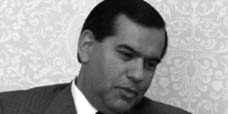
Dayton Daily News Investigative Reporter Russell Carollo says the Peace Corps was the last place he thought he'd find an idea for a long-term project and the last place he thought he would find a federal agency with something to hide
PEACE CORPS
Jul 1, 2004
IRE Journal
by Russell Carollo
Violence against volunteers worldwide found in database checks, interviews
Volunteer Michael Coleman watches students perform a skit in Lesotho.
The Peace Corps was the last place I thought I'd find an idea for a long-term project and the last place I thought I would find a federal agency with something to hide.
This was, after all, the Peace Corps.
But several years ago, while scanning the semiannual report to Congress from the Peace Corps Office of Inspector General, 1 noticed reports of rapes and other assaults, brief descriptions of violent attacks, mostly directed at young female volunteers.
Subsequent reports had similar accounts of attacks, so I decided to put the idea on a projects list - not as a proposal for a major project but as a potential story idea someone else might be interested in. My suggestion caught the eye of Mike Wagner, a projects reporter at the Dayton (Ohio) Daily News, and he insisted during a projects meeting this was a major story that would shock Americans.
Thus began a 20-month examination that led us to 500 interviews in the United States and 10 other countries, more than 75 Freedom of Information Act requests and appeals, a months-long legal battle that ended in a federal lawsuit, never-before released computer databases and a personal request that our editor testify before a congressional hearing.
Wall of resistance
The project began with a search of LexisNexis. The search disclosed no major projects on the subject and very few stories of any kind about assaults or deaths. The next and most important question I had to answer before proceeding was: Is there a way to find and document numerous examples of this problem?
I quickly found an endless supply of former volunteers who were relatively easy to identify through volunteer associations, through Google, Nexis, Yahoo or Auto Track XP, a paid service. In most cases, volunteers had at least some information on assaults occurring while they were in a country, and just about every volunteer had been the victim of a serious crime or knew of someone who had.
Once we were sure we had a project, a second reporter, Christine Willmsen, was assigned and spent months on the project before taking a job at The Seattle Times. Later, Mei-Ling Hopgood, our Washington correspondent, took over and worked with me for the remainder of the project.
For actual records on the assaults and for overall statistics, I started filing the first of the FOI requests and appeals, including one for the agency's main database on assaults: the Assault Notification Surveillance System database. In the meantime, I went to the Peace Corps spokeswoman.
I met a wall of resistance.

The spokeswoman refused to answer even the most basic questions about assaults and referred me to the FOIA office. A search of Nexis showed that the same woman was being quoted regularly by newspapers reporting positive stories about the agency. The FOIA office refused to even acknowledge receipt of some of my requests and refused to provide proper acknowledgment letters on others. I appealed for lack of proper response.
When the agency did finally release something to me, it was virtually worthless. Among the pieces of information the agency denied: the countries where assaults occurred, dates of assaults, dates of reports, days of the week assaults occurred, times of the assaults, whether local authorities were notified of assaults (yes or no), whether victims were medically evacuated, general information about the types of places where the assault occurred and brief descriptions of the attacks.
All this information, according to the Peace Corps, was being withheld to "protect the privacy interest of individuals." Since we weren't demanding the names of the victims and since just about every law enforcement agency in America releases the same information, I appealed, challenging the agency to defend how such things as the name of a country would violate someone's personal privacy.
When nothing seemed to work, I went to our attorneys, and in November 2002, we filed a lawsuit in federal court against the Peace Corps.
Easy targets

The agency suddenly became much more cooperative, giving us a copy of nearly its entire assault database. An analysis of the data disclosed that assaults against volunteers increased 200 percent between 1990 and 2002, while the number of volunteers increased 29 percent. That included a 300 percent increase in aggravated assaults. We decided to leave off the first year of collection and still found a 125 percent increase. In 2002, we found, a volunteer was assaulted or robbed every 23 hours.
Meanwhile, through countless hours of interviews, we found the Peace Corps was being run in a way that would seem ridiculous to any business.
Few of the volunteers we interviewed had any real background in the jobs they were given. Recent college graduates who had never grown a flower were being asked to teach farmers how to grow crops in countries where the volunteers had only recently arrived. Volunteers who never held a real job were being asked to show other people how to run businesses.
Not only did volunteers lack experience in the subjects they were teaching, but they also often lacked the ability to speak the language well enough to communicate effectively.
Making matters worse was the fact that the Peace Corps had no written policy on how often supervisors were supposed to visit volunteers, and some volunteers went months without visits at their sites from supervisors.
Frustrated and with an abundance of free time, some volunteers turned to drinking, using drugs, entering into relationships with foreigners they hardly knew, taking unauthorized vacations - sometimes alone - or engaging in other activities that made them easy targets for assault.
"I don't like living in fear,"says University of Dayton graduate and Peace Corps volunteer Michelle Ervin, as she rides a bus in Cape Verde. Most of the Corps'volunteers - and most of its victims - are young women.
And the majority of volunteers were those most vulnerable to assaults: women, who now make up more than half of all volunteers. In one African country we visited, up to 90 percent of the volunteers were women.
Despite all these problems, the Peace Corps insisted on sending volunteers alone to remote sites, sometimes with little means to communicate with the outside world.
Just weeks before publication and after more than 18 months of work, we were able to get a copy of the agency's Deaths in Service database and found even more troubling things about the agency.
Pattern of misinformation

We already planned to report that the agency kept crucial details about some deaths from families and the public. We had gone to the Ukraine and walked across the same bridge the Peace Corps claimed 27- year-old Brian Krow accidentally fell from days after he received a letter threatening him with expulsion. The bridge had chest-high railing on both sides, and the prosecutor who investigated the case told us that the Peace Corps never told him Krow faced expulsion and wouldn't allow him to question other volunteers about Krow.
While there, we also looked into the death of 64-year-old Victor Verloo and learned that his family was never made fully aware of his involvement with a 28-year-old Ukrainian woman or the crucial role she played in his death.
Still, the death database helped us to establish a pattern of misinformation that had gone on since nearly the beginning of the agency more than 40 years earlier. just a glance of the description field in the database was enough to pique our suspicion.
The database, for example, says 26-year-old Guatemala volunteer Joseph Teates was found hanging from ropes attached to his neck and feet in june of 1987, yet the Peace Corps called it an accident. We tracked down his family and learned that he had a history of mental problems, drug abuse and a police record the Peace Corps apparently wasn't fully aware of when it accepted him.
The death of 22-year-old Linda Fink in Lemfu, Zaire, in 1973 was one of several attributed to an animal attack, but we learned later that she had written a resignation letter the day she disappeared and that the agency suspected suicide - facts the family was never told.
In several deaths, the Peace Corps explanation was a likely cause, but not nearly as likely as the database indicated. The database, for example, concluded that 24-year-old Bethanne Bahler of Wabash, Ind., "slipped on rocks while crossing cascade." We learned later that her body was found floating in the water after becoming separated from a group of volunteers vacationing in Jamaica and that no one actually saw her fall off anything.
Twenty days after Bahler's death, a 24-year-old volunteer died in Afghanistan, and the explanation by the Peace Corps was nearly identical: "Slipped on rocks into rapids while fishing." We tracked down the woman's husband, who was fishing with her that day, and even he didn't know of anyone who actually saw her fall in.
We also found major problems with the agency's crime data.
The Peace Corps didn't start collecting worldwide crime statistics until 1990 - 28 years after it first sent volunteers overseas. Certain crimes still weren't specifically identified atall on the assault database, such as abductions, kidnappings and even murder, which is usually counted as an assault in the data.
Some crimes that should have appeared in the data just weren't there at all. Underreporting was estimated by government auditors to be as high as 50 percent.
When we asked Elliot Jaspin of the Cox Newspapers' bureau in Washington, D.C., to look over our findings before publication, he found something even more troubling: The crime rate the agency was making available to Congress and the public was based on the number of volunteers in a country, but it wasn't based on the number of volunteers being victimized. Instead, the agency was counting only "incidents," ignoring the fact that many incidents had multiple victims. For example, when three women were raped and two male volunteers were assaulted in a single incident in El Salvador in 1996, statistics reflected a single rape.
About one in every five assaults involved more than one volunteer, but it was impossible through the data provided to determine what happened to all the other volunteers in each case.
Jaspin, who founded what is today the National Institute for Computer-Assisted Reporting, confronted Peace Corps officials, but they insisted that their data collection methods were the best way to make volunteers safer.

The Peace Corps continued to defend itself after our seven-part series, "Casualties of Peace," was published from Oct. 26 to Nov. 1, 2003. Though the agency has yet to point out a single factual error in our reporting, it criticized our work and questioned our motives. The agency has yet to acknowledge a single mistake or institute a single reform as the result of our work. Within weeks of publication, however, the Peace Corps redesigned its Web site to include extensive information on safely and security.
As the series was being published, Ohio's two senators formally requested a Senate committee hearing, and that request is pending.
On March 24, the House Committee on International Relations held a hearing as the result of our work, and six days later, the committee passed a bill to enhance safety of volunteers.
At the hearing, Chairman Henry Hyde, R-IlL, read into the record a quote published in our series that came from Patrick Sullivan, a GAO special investigator and a 23-year veteran of the U.S. secret Service who was sent to Bolivia to investigate the disappearance of a volunteer:
"We believe that the Peace Corps severely failed their people, their volunteers, and knowing what I know, there is no way 1 would let my children volunteer for the Peace Corps unless there was some immediate changes and serious changes in the Peace Corps."
BY RUSSELL CAROLLO
DAYTON (OHIO) DAILY NEWS
Russell Carollo has been a special projects reporter for the Dayton Daily News since 1990. he and MaLi ng Hopgood won an IRE Award for "Casualties of Peace" this year.
Copyright Investigative Reporters & Editors Jul/Aug 2004






